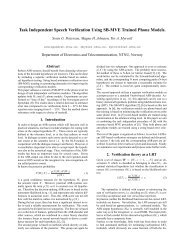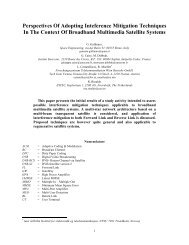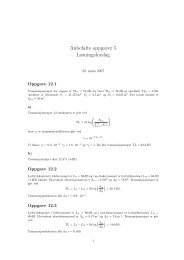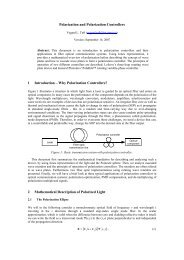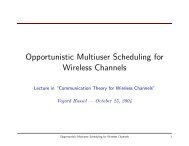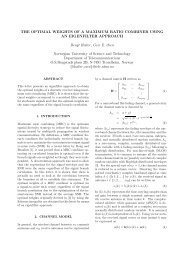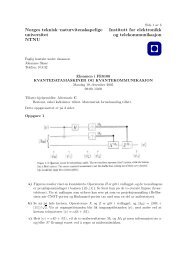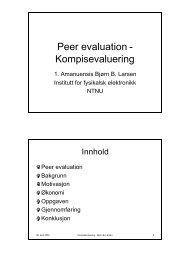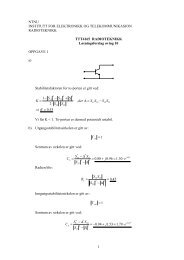A quadratic programming problem arising from vector ... - NTNU
A quadratic programming problem arising from vector ... - NTNU
A quadratic programming problem arising from vector ... - NTNU
You also want an ePaper? Increase the reach of your titles
YUMPU automatically turns print PDFs into web optimized ePapers that Google loves.
International Workshop on Statistical-Mechanical Informatics 2007 (IW-SMI 2007)<br />
IOP Publishing<br />
Journal of Physics: Conference Series 95 (2008) 012006<br />
doi:10.1088/1742-6596/95/1/012006<br />
A <strong>quadratic</strong> <strong>programming</strong> <strong>problem</strong> <strong>arising</strong> <strong>from</strong><br />
<strong>vector</strong> precoding in wireless communications<br />
Ralf R Müller 1 , Dongning Guo 2 and Aris L Moustakas 3<br />
1 Department of Electronics & Telecommunications, Norwegian University of Science and<br />
Technology, Trondheim, Norway<br />
2 Department of Electrical Engineering & Computer Science, Northwestern University,<br />
Evanston, IL, USA<br />
3 Physics Department, National & Kapodistrian University of Athens, Athens, Greece<br />
E-mail: ralf@iet.ntnu.no, dGuo@northwestern.edu, arislm@phys.uoa.gr<br />
Abstract. A <strong>quadratic</strong> <strong>programming</strong> <strong>problem</strong> is studied in the limit of asymptotically large<br />
kernel matrices by means of the replica method. It is found that inverse Wishart kernels<br />
are—within the validity range of the replica symmetric solution—asymptotically invariant to<br />
Cartesian relaxations. In the context of <strong>vector</strong> precoding for wireless communication systems<br />
with dual antenna arrays, so-called MIMO systems, this implies that adding more transmit<br />
antennas cannot reduce the minimum required transmit energy per bit significantly. By contrast,<br />
a new convex relaxation is proposed and shown to be a practical and useful method.<br />
1. Introduction<br />
Non-convex <strong>quadratic</strong> <strong>programming</strong> <strong>problem</strong>s arise in many applications in wireless<br />
communications. One of them is <strong>vector</strong> precoding for wireless multiple-input multiple-output<br />
(MIMO) systems [1, 2]. Wireless MIMO technology promises to increase data rate over<br />
conventional wireless communications without need for more physical radio spectrum by means<br />
of multiple antenna elements at both the transmitter side and the receiver side [3, 4]. As a<br />
design choice, there can be need for major signal processing at the receiver side, the transmitter<br />
side or both of them. Here, we are concerned with systems where sophisticated signal processing<br />
is required solely at the transmitter side. This is advantageous for transmitting data to low-cost<br />
or battery-driven devices such as cell-phones and personal digital assistants (PDAs).<br />
It is an unavoidable feature of wireless MIMO systems that signals sent <strong>from</strong> different antenna<br />
elements of the transmit array are received with severe crosstalk at the respective antenna<br />
elements of the receive array. In order to compensate for the crosstalk, one can use linear<br />
joint transmitter processing, also known as linear <strong>vector</strong> precoding, as suggested in [5, 6].<br />
This comes, however, at the expense of the need for an increased transmit power in order<br />
to maintain the distance properties of the received signal constellation. A more sophisticated<br />
method for transmitter processing is nonlinear <strong>vector</strong> precoding, which is simply referred to as<br />
<strong>vector</strong> precoding in this work. It is based on the concept of Tomlinson-Harashima precoding<br />
[7, 8] which was originally proposed to combat intersymbol interference. It was proposed for use<br />
in the context of MIMO systems in [1, 2]. For a general survey on <strong>vector</strong> precoding the reader<br />
is referred to [9].<br />
c○ 2008 IOP Publishing Ltd 1
International Workshop on Statistical-Mechanical Informatics 2007 (IW-SMI 2007)<br />
IOP Publishing<br />
Journal of Physics: Conference Series 95 (2008) 012006<br />
doi:10.1088/1742-6596/95/1/012006<br />
In this work, we are mainly concerned with the performance analysis of <strong>vector</strong> precoding in<br />
the limit where the number of antennas goes to infinity. This <strong>problem</strong> was addressed in [10]<br />
employing the replica method which was originally invented for the analysis of spin glasses in<br />
statistical physics [11, 12] and has become increasingly powerful to address <strong>problem</strong>s in wireless<br />
communications and coding theory [13].<br />
The remainder of the paper consists of five sections. Section 2 shows that inverse Wishart<br />
kernels are asymptotically invariant to Cartesian relaxations. Section 3 introduces <strong>vector</strong><br />
precoding and discusses the implications of section 2. Section 4 proposes a new convex relaxation<br />
of the signal set to reduce the complexity of <strong>vector</strong> precoding and compares its performance to<br />
the benchmarks found in [10]. Section 5 concludes the paper.<br />
2. An invariance property of the inverse Wishart kernel<br />
Consider the following <strong>quadratic</strong> <strong>programming</strong> <strong>problem</strong><br />
with<br />
E(ρ) = 1 K min<br />
x∈X x† Jx (1)<br />
X = X 1 × X 2 × · · · × X K × R, (2)<br />
X k ⊆ C, k = 1, 2, . . . and R ⊆ C ⌈ρK⌉ . In the limit K → ∞, the <strong>problem</strong> is well-defined for<br />
any ρ ≥ 0 and any random matrix J ∈ C ⌈K+ρK⌉×⌈K+ρK⌉ which provides enough randomness to<br />
make the <strong>quadratic</strong> <strong>programming</strong> <strong>problem</strong> self-averaging.<br />
We call the <strong>problem</strong> E(ρ) for any ρ > 0 a Cartesian relaxation of the <strong>problem</strong> E(0), since<br />
the constraint set is relaxed by a Cartesian product between the original constraint set and the<br />
relaxation set R. Since relaxations cannot hurt, we have<br />
dE(ρ)<br />
dρ<br />
≤ 0. (3)<br />
In <strong>vector</strong> precoding for wireless communication systems the kernel takes the form of an inverse<br />
Wishart matrix. That is, let H ∈ C K×K/α , α ≤ 1 be composed of independent identically<br />
distributed zero-mean complex Gaussian entries, we have<br />
J = (HH † ) −1 . (4)<br />
Intuitively, one would expect (3) to hold with strict inequality in most non-trivial cases. Thus,<br />
when studying such relaxations by means of replica symmetric analysis, it came as a surprise<br />
to the authors to discover that, for an inverse Wishart matrix, (3) holds with equality, i.e. the<br />
(rather generous) relaxation of the constraint set does not reduce the objective function.<br />
We will devote the remainder of this section to manifest this invariance property of the inverse<br />
Wishart kernel within the limitations of the replica-symmetric ansatz. We are aware of the<br />
fact that <strong>quadratic</strong> <strong>programming</strong> <strong>problem</strong>s, as they can be formulated as ground state energy<br />
<strong>problem</strong>s, are vulnerable to replica-symmetry breaking. Nevertheless, the replica-symmetric<br />
ansatz still provides strict inequality in (3) for e.g. the standard Wishart kernel and presumably<br />
most other random matrices. If after all, it will turn out that the discovered invariance is not<br />
a feature of the inverse Wishart kernel but the replica symmetric solution of the <strong>quadratic</strong><br />
<strong>programming</strong> <strong>problem</strong>, we hope that our discovery can still be helpful for a better insight into<br />
replica symmetry and its limitations.<br />
We start <strong>from</strong> a result we recently showed in context of <strong>vector</strong> precoding for wireless multiantenna<br />
communication systems [10].<br />
2
International Workshop on Statistical-Mechanical Informatics 2007 (IW-SMI 2007)<br />
IOP Publishing<br />
Journal of Physics: Conference Series 95 (2008) 012006<br />
doi:10.1088/1742-6596/95/1/012006<br />
Proposition 1 Let the following assumption hold:<br />
(i) The random matrix J is bi-unitarily invariant, i.e. it can be de-composed into J = ODO †<br />
such that the matrices D and O are diagonal and Haar distributed, respectively. Moreover,<br />
as K → ∞, the asymptotic eigenvalue distribution of J converges to a non-random<br />
distribution function which can be uniquely characterized by its R-transform R(w) 1 .<br />
(ii) The <strong>quadratic</strong> <strong>programming</strong> <strong>problem</strong> (1) is self-averaging.<br />
(iii) The parameters q and b are solutions to the following pair of coupled fixed-point equations<br />
1<br />
q = lim<br />
K→∞ K<br />
1<br />
b = lim<br />
K→∞ K<br />
K∑<br />
∫ ∣ ∣ √<br />
∣∣ ∣∣∣∣ ∣∣∣ qR<br />
argmin z<br />
′ (−b) ∣∣∣∣ ∣∣∣∣<br />
2<br />
k=1<br />
x∈X k<br />
2R 2 (−b) − x Dz (5)<br />
K∑<br />
∫ { ∣ √<br />
∣ }<br />
∣∣∣∣<br />
qR<br />
R argmin z<br />
′ (−b) ∣∣∣∣<br />
x∈X k<br />
2R 2 (−b) − x z ∗ Dz<br />
√<br />
2qR ′ (−b) . (6)<br />
k=1<br />
with Dz = exp(−z 2 /2)/(2π)dz being the complex Gaussian measure.<br />
Then, if 0 < b < ∞, the replica symmetric ansatz yields<br />
as K → ∞.<br />
E(0) → q ∂ bR(−b) (7)<br />
∂b<br />
In order to fit (1) into the framework of Proposition 1, we first let R = C ⌈ρK⌉ without loss<br />
of generality. Thus, we find<br />
with<br />
˜q =<br />
⎡<br />
1<br />
⎣ρ ˜qR′ (−˜b)<br />
1 + ρ R 2 (−˜b) + lim<br />
⎡<br />
˜b =<br />
1<br />
1 + ρ<br />
⎣<br />
K→∞<br />
ρ<br />
R(−˜b) + lim 1<br />
K→∞ K<br />
E(ρ) → (1 + ρ) ˜q ∂ ∂˜b<br />
˜bR(−˜b) (8)<br />
1<br />
K<br />
K∑<br />
∫ ∣ ∣ √<br />
∣∣ ⎤<br />
∣∣∣∣ ∣∣∣ ˜qR<br />
argmin z<br />
′ (−˜b) ∣∣∣∣ ∣∣∣∣<br />
2<br />
2R 2 (−˜b) − x Dz⎦ (9)<br />
k=1<br />
K∑<br />
∫<br />
k=1<br />
R<br />
{<br />
x∈X k<br />
argmin<br />
x∈X k<br />
∣ √ ∣∣∣∣<br />
z<br />
∣ }<br />
˜qR ′ (−˜b) ∣∣∣∣<br />
2R 2 (−˜b) − x z ∗<br />
Dz<br />
√<br />
2˜qR ′ (−˜b)<br />
⎤<br />
⎦. (10)<br />
For the inverse Wishart matrix we find <strong>from</strong> [10]<br />
R(−˜b) = ˜α − 1 + √<br />
(1 − ˜α) 2 + 4˜α˜b<br />
R ′ (−˜b) =<br />
(<br />
˜α − 1 +<br />
2˜α˜b<br />
√<br />
(1 − ˜α) 2 + 4˜α˜b<br />
4˜α˜b 2 √(1 − ˜α) 2 + 4˜α˜b<br />
) 2<br />
(11)<br />
(12)<br />
with ˜α = (1 + ρ)α and α being a free parameter of the Wishart distribution. It also turns out<br />
helpful to recognize that<br />
√<br />
R 2 (−˜b)<br />
R ′ (−˜b) = (1 − ˜α) 2 + 4˜α˜b<br />
(13)<br />
˜α<br />
1 The R-transform of a measure µ(X) is given as R(w) = G −1 (−w) − w −1 where G −1 (·) is the functional inverse<br />
(inverse with respect to composition) of G(·) and G(w) = R (X − w) −1 dµ(X) [14, 15].<br />
3
International Workshop on Statistical-Mechanical Informatics 2007 (IW-SMI 2007)<br />
IOP Publishing<br />
Journal of Physics: Conference Series 95 (2008) 012006<br />
doi:10.1088/1742-6596/95/1/012006<br />
and it is convenient to replace the parameter ˜b by the substitution<br />
√<br />
˜p = (1 − ˜α) 2 + 4˜α˜b. (14)<br />
Thus, we get<br />
˜q =<br />
⎡<br />
1 ˜q 1<br />
⎣ρ + lim<br />
(1 + ρ)<br />
˜α˜p K→∞ K<br />
[ √<br />
˜b =<br />
1<br />
(1 + ρ)R(−˜b)<br />
ρ +<br />
K∑<br />
∫ ∣ ∣ √ ∣∣ ⎤<br />
∣∣∣∣ ∣∣∣ ˜q ˜α ∣∣∣∣ ∣∣∣∣<br />
2<br />
argmin z<br />
2˜p − x Dz⎦ (15)<br />
k=1<br />
˜p<br />
2˜q ˜α lim<br />
K→∞<br />
1<br />
K<br />
x∈X k<br />
K∑<br />
∫<br />
k=1<br />
R<br />
{<br />
argmin<br />
x∈X k<br />
∣ √ ∣∣∣∣<br />
z<br />
∣ }<br />
˜q ˜α ∣∣∣∣<br />
2˜p − x z ∗ Dz<br />
E(ρ) = (1 + ρ) . (17)<br />
˜q˜p<br />
Plugging (11) into (16), and re-arranging terms, we find<br />
˜p = 1 − ˜α +<br />
[ √<br />
2˜α ρ +<br />
1 + ρ<br />
˜p<br />
2˜q ˜α lim<br />
K→∞<br />
1<br />
K<br />
K∑<br />
∫<br />
k=1<br />
R<br />
{<br />
argmin<br />
x∈X k<br />
∣ √ ∣∣∣∣<br />
z<br />
∣ }<br />
˜q ˜α ∣∣∣∣<br />
2˜p − x z ∗ Dz<br />
]<br />
]<br />
(16)<br />
. (18)<br />
Thus, we find <strong>from</strong> (17)<br />
E(ρ) =<br />
ρ E(ρ)α + lim<br />
K→∞<br />
1 − ˜α + 2αρ +<br />
√<br />
2α<br />
E(ρ)<br />
1<br />
K<br />
lim<br />
K→∞<br />
K∑<br />
k=1<br />
1<br />
K<br />
∫ ∣ ∣ ∣∣∣<br />
√<br />
∣∣ E(ρ)α<br />
2<br />
argmin x∈Xk z<br />
2<br />
− x<br />
∣∣<br />
Dz<br />
{<br />
∣<br />
K∑ ∫ ∣∣∣<br />
√<br />
}<br />
R<br />
E(ρ)α<br />
argmin x∈Xk z<br />
2<br />
− x<br />
∣ z∗ Dz<br />
k=1<br />
(19)<br />
and after some trivial algebra<br />
E(ρ) =<br />
1<br />
lim<br />
K→∞<br />
K<br />
1 − α +<br />
√<br />
2α<br />
E(ρ)<br />
K∑<br />
k=1<br />
lim<br />
K→∞<br />
∫ ∣ ∣ ∣∣∣<br />
√<br />
∣∣ E(ρ)α<br />
argmin x∈Xk z<br />
2<br />
− x∣<br />
1<br />
K<br />
K∑<br />
k=1<br />
{<br />
∣<br />
∫ ∣∣∣<br />
√<br />
R argmin x∈Xk z<br />
Clearly, E(ρ) does not depend on ρ and the proof is complete.<br />
2<br />
∣∣<br />
Dz<br />
} . (20)<br />
2<br />
− x<br />
∣ z∗ Dz<br />
E(ρ)α<br />
3. Vector precoding<br />
Following [10], <strong>vector</strong> precoding is conveniently introduced in a general way as follows:<br />
Vector precoding aims to minimize the transmitted power that is associated with the<br />
transmission of a certain data <strong>vector</strong> s ∈ S K of length K. For that purpose, the original symbol<br />
alphabet S is relaxed into the alphabet B. The data representation in the relaxed alphabet is<br />
redundant. That means that several symbols in the relaxed alphabet represent the same data.<br />
Due to the redundant representation, we can now choose that representation of our data which<br />
requires the least power for transmission. This way of saving transmit power is what we call<br />
<strong>vector</strong> precoding.<br />
That means, for any s ∈ S there is a set B s ⊂ B such that all elements of B s represent the data<br />
s. Take quaternary phase-shift keying (QPSK) as an example, i.e. S = {00, 01, 10, 11}. Let j =<br />
√ −1. Without <strong>vector</strong> precoding, it is most common (Gray mapping) to choose B00 = {+1 + j},<br />
B 01 = {+1 − j}, B 10 = {−1 + j}, and B 11 = {−1 − j}. For QPSK modulation, <strong>vector</strong> precoding<br />
4
International Workshop on Statistical-Mechanical Informatics 2007 (IW-SMI 2007)<br />
IOP Publishing<br />
Journal of Physics: Conference Series 95 (2008) 012006<br />
doi:10.1088/1742-6596/95/1/012006<br />
Figure 1. Four equally spaced integer lattices representing the four QPSK states 00, 01, 10,<br />
and 11, respectively.<br />
is the idea to have B 00 ⊃ {+1 + j}, B 01 ⊃ {+1 − j}, B 10 ⊃ {−1 + j} and B 11 ⊃ {−1 − j}, i.e.<br />
to allow for supersets of the quaternary constellation. A popular choice for those supersets<br />
is due to Tomlinson, Harashima, and Miyakawa [7, 8] where B 00 = (4Z + 1) × (4jZ + j),<br />
B 01 = (4Z + 1) × (4jZ − j), B 10 = (4Z − 1) × (4jZ + j), and B 11 = (4Z − 1) × (4jZ − j) are<br />
disjoint subsets of the odd integer lattice points (see also figure 1).<br />
In order to avoid ambiguities, we should have<br />
B i ∩ B j = ∅ ∀i ≠ j. (21)<br />
In addition, one would like to design the sets B i such that the distance properties of the received<br />
signals are preserved. This is for instance easily achieved by letting the sets B i to be distinct<br />
sub-lattices of B as in figure 1. However, the choice of non-convex sets B i in general leads to<br />
NP-hardness of the <strong>vector</strong> precoding <strong>problem</strong>. Therefore, it is advantageous to use convex sets<br />
B i even if that increases the transmitted energy per symbol for sake of feasibility.<br />
Let s = [s 1 , . . . , s K ] T denote the information to be encoded. Let t = T x be the K/α × 1<br />
<strong>vector</strong> being sent where α denotes the ratio between data streams to transmit antennas and the<br />
K × 1 <strong>vector</strong> x be the redundant representation of the data. Then, the precoding <strong>problem</strong> can<br />
be written as the minimization of the following <strong>quadratic</strong> form<br />
over the discrete set<br />
min ||T<br />
x∈X x||2 = min<br />
x∈X x† Jx (22)<br />
X = B s1 × B s2 × · · · × B sK (23)<br />
with J = T † T .<br />
Consider a <strong>vector</strong>-valued communication system. Let the received <strong>vector</strong> be given as<br />
r = Ht + n (24)<br />
5
International Workshop on Statistical-Mechanical Informatics 2007 (IW-SMI 2007)<br />
IOP Publishing<br />
Journal of Physics: Conference Series 95 (2008) 012006<br />
doi:10.1088/1742-6596/95/1/012006<br />
where n is additive noise. Let the components of the transmitted and received <strong>vector</strong>s be signals<br />
sent and received at different antenna elements, respectively.<br />
We want to ensure that the received signal is (up to additive noise) identical to the data<br />
<strong>vector</strong>. This design criteria leads us to choose the precoding matrix<br />
T = H † ( HH †) −1<br />
. (25)<br />
This means that we invert the channel and get r = x + n if the matrix inverse exists. This<br />
allows to keep the signal processing at the receiver at a minimum. This is advantageous if the<br />
receiver shall be a low-cost or battery-powered device.<br />
To model the statistics of the entries of H is a non-trivial task and a topic of ongoing research,<br />
see e.g. [16] and references therein. For sake of convenience, we choose in this first order approach<br />
that the entries of the channel matrix H are independent and identically distributed complex<br />
Gaussian random variables with zero mean and variance α/K. Thus, the kernel matrix J is an<br />
inverse Wishart matrix.<br />
For inverse Wishart matrices, the invariance property found in section 2 applies. But what<br />
does it mean in context of <strong>vector</strong> precoding? A Cartesian relaxation in a MIMO system with<br />
<strong>vector</strong> precoding would be to add a couple of receive antennas, precisely speaking ρK of them<br />
to the K receive antennas already in use and design dummy data-streams for those receive<br />
antennas. The dummy data does not bear any useful information, but intends to reduce the<br />
radiated power at the transmit antennas. The invariance property for inverse Wishart matrices<br />
means in this context that, regardless of how many additional receive antennas we provide and<br />
regardless how we design the dummy data, the radiated power at the transmitter will not decay.<br />
The situation does not become better for Cartesian relaxations if we are willing to compromise<br />
on the data rate. That is, we do not add receive antennas, but reduce the total data rate in<br />
order to free some of the existing receive antennas for the dummy data. In such a case we would<br />
reduce the radiated power at the transmit antennas. However, we could achieve the same power<br />
saving by simply shutting down those receive antennas that are meant to receive the dummy<br />
data.<br />
4. A new convex relaxation<br />
We aim to perform <strong>vector</strong> precoding at feasible complexity. Lattice precoding performs very<br />
well [10], but is NP-hard. We have seen in section 2 that Cartesian relaxations do not help.<br />
In order to allow for polynomial complexity, we should allow for convex sets. Since we should<br />
not reduce the minimum distance between the signal constellation, it seems intuitive to try the<br />
following convex relaxation:<br />
S = {00, 01, 10, 11} (26)<br />
B 00 = {z ∈ C : Rz ≤ −1 ∧ Iz ≤ −1} (27)<br />
B 01 = {z ∈ C : Rz ≤ −1 ∧ Iz ≥ +1} (28)<br />
B 10 = {z ∈ C : Rz ≥ +1 ∧ Iz ≤ −1} (29)<br />
B 11 = {z ∈ C : Rz ≥ +1 ∧ Iz ≥ +1} (30)<br />
These signal sets are depicted in figure 2. All these signal sets are convex. The kernel matrix<br />
J is positive-semidefinite. Therefore, the corresponding <strong>quadratic</strong> <strong>programming</strong> <strong>problem</strong>s can<br />
be solved in polynomial time. Furthermore, the mapping is independent of each other in both<br />
quadrature components.<br />
From Proposition 1 and (14), we get<br />
q =<br />
∫ ∣ ∣ ∣∣∣<br />
argmin<br />
x∈B 11<br />
∣ √ ∣∣∣∣<br />
z<br />
∣∣ qR ′ (−b) ∣∣∣∣ ∣∣∣∣<br />
2<br />
2R 2 (−b) − x Dz (31)<br />
6
International Workshop on Statistical-Mechanical Informatics 2007 (IW-SMI 2007)<br />
IOP Publishing<br />
Journal of Physics: Conference Series 95 (2008) 012006<br />
doi:10.1088/1742-6596/95/1/012006<br />
Figure 2. Complex convex relaxation representing the four quaternary states 00, 01, 10, and<br />
11, respectively.<br />
=<br />
√<br />
2<br />
π<br />
∫<br />
+∞<br />
−∞<br />
⎧<br />
⎨ 1 z <<br />
⎩<br />
z 2 qα<br />
(√ 2p<br />
= 2 − 2Q<br />
qα<br />
∫ { ∣ √ ∣∣∣∣<br />
b = R argmin z<br />
x∈B 11<br />
√ p 2<br />
p = 1 − α + 2α<br />
2qα√<br />
π<br />
= 1 − α + 2α Q<br />
√<br />
2p<br />
qα<br />
√<br />
2p<br />
qα<br />
⎫<br />
⎬<br />
2p<br />
z ><br />
)<br />
+ qα (√ 2p<br />
p Q qα<br />
∣ }<br />
qR ′ (−b) ∣∣∣∣<br />
2R 2 (−b) − x z ∗<br />
(√ 2p<br />
qα<br />
∫<br />
+∞<br />
−∞<br />
⎩<br />
⎭ exp(−z2 /2)dz (32)<br />
) √ ( qα<br />
+<br />
πp exp − p )<br />
qα<br />
⎧<br />
⎨ z z <<br />
z 2√ qα<br />
2p<br />
z ><br />
Dz<br />
√<br />
2qR ′ (−b)<br />
√<br />
2p<br />
qα<br />
√<br />
2p<br />
qα<br />
⎫<br />
⎬<br />
(33)<br />
(34)<br />
⎭ exp(−z2 /2)dz (35)<br />
)<br />
. (36)<br />
with Q(x) = ∫ ∞<br />
x exp(−x2 /2)dx/ √ 2π. Finally, we can use (36) to simplify (33)<br />
q = 2 + 2 − 2p − q √ ( qα<br />
α p (1 − α) + 2 πp exp − p )<br />
. (37)<br />
qα<br />
The solutions to these fixed point equations are shown in figure 3. For unit load, the energy<br />
per symbol is found to be approximately 3 times higher than with lattice precoding. This is<br />
the price to be paid for precoding with polynomial complexity. In comparison to sole channel<br />
inversion, the proposed convex relaxation allows to increase the load by about 30% without need<br />
for more transmitted energy. This means that the transmitter can achieve the same performance<br />
with at least 30% fewer transmit antennas.<br />
7
International Workshop on Statistical-Mechanical Informatics 2007 (IW-SMI 2007)<br />
IOP Publishing<br />
Journal of Physics: Conference Series 95 (2008) 012006<br />
doi:10.1088/1742-6596/95/1/012006<br />
20<br />
16<br />
12<br />
E<br />
8<br />
4<br />
0<br />
0 0.2 0.4 0.6 0.8 1<br />
α<br />
Figure 3. Energy per symbol versus the load for channel inversion and precoding for Graymapped<br />
QPSK. The solid line refers to the proposed convex relaxation. For comparison the<br />
dashed and dash-dotted lines show precoding with the odd integer lattice and sole channel<br />
inversion, respectively, as calculated in [10].<br />
The considerations in the above paragraph concerning the performance of the proposed convex<br />
relaxation are somewhat pessimistic. Admittedly, the energy per symbol is about 3 times larger<br />
than with lattice precoding. However, this is not the full story. Lattice precoding preserves<br />
the average minimum distance to signal points of other sets. The proposed convex relaxation,<br />
however, increases the average minimum distance and, therefore, makes the signal more robust<br />
against channel impairments such as additive noise and fading.<br />
The increase in average minimum distance is directly quantified by the parameter<br />
1<br />
q = lim<br />
K→∞ K x† x. (38)<br />
This parameter is shown in figure 4. For unit load, the parameter q takes the value of<br />
approximately 5.8 which suggests an increase of the average squared distance by a factor of<br />
approximately 2.9. Thus, tripling the transmit power in comparison to lattice precoding, comes<br />
almost with a tripling of average squared distance.<br />
5. Conclusions<br />
We found that Cartesian relaxations do not help to reduce the transmitted power for inversion<br />
of <strong>vector</strong> channels with independent identically distributed channel matrices. Instead the convex<br />
relaxation proposed in this work gives noticeable gains over pure channel inversion for loads close<br />
to unity. The convex relaxation also comes with an increase in the average minimum distance<br />
between signal points which provides additional robustness against additive and multiplicative<br />
channel noise.<br />
8
International Workshop on Statistical-Mechanical Informatics 2007 (IW-SMI 2007)<br />
IOP Publishing<br />
Journal of Physics: Conference Series 95 (2008) 012006<br />
doi:10.1088/1742-6596/95/1/012006<br />
10 0 α<br />
q,p,b<br />
10 −1<br />
10 −2<br />
0 0.2 0.4 0.6 0.8 1<br />
Figure 4. Parameters q, p, and b versus load α shown by the solid, dashed, and dash-dotted<br />
lines, respectively.<br />
Acknowledgments<br />
This research was supported by the Research Council of Norway and the European Commission<br />
under grants 171133/V30 and MIRG-CT-2005-030833, resp. This work was initiated while<br />
R. Müller and D. Guo were visiting the Institute for Mathematical Sciences at the National<br />
University of Singapore in 2006.<br />
References<br />
[1] Windpassinger C, Fischer R F H, Vencel T and Huber J B 2004 IEEE Transactions on Wireless<br />
Communications 3 1305–1316<br />
[2] Hochwald B M, Peel C and Swindlehurst A 2005 IEEE Transactions on Communications 53 537–544<br />
[3] Foschini G and Gans M 1998 Wireless Personal Communications 6 311–335<br />
[4] Telatar I E 1999 European Transactions on Telecommunications 10 585–595<br />
[5] Vojčić B R and Jang W M 1998 IEEE Transactions on Communications 46 1346–1355<br />
[6] Peel C B, Hochwald B M and Swindlehurst A L 2005 IEEE Transactions on Communications 53 195–202<br />
[7] Tomlinson M 1971 IEE Electronics Letters 7 138–139<br />
[8] Harashima H and Miyakawa H 1972 IEEE Transactions on Communications COM-20 774–780<br />
[9] Fischer R F 2002 Precoding and Signal Shaping for Digital Transmission (John Wiley & Sons)<br />
[10] Müller R R, Guo D and Moustakas A L 2007 Submitted to IEEE Journal on Selected Areas in Communications<br />
ArXiv:0706.1169v1 [cs.IT]<br />
[11] Mezard M, Parisi G and Virasoro M A 1987 Spin Glass Theory and Beyond (Singapore: World Scientific)<br />
[12] Fischer K and Hertz J 1991 Spin Glasses (Cambridge, U.K.: Cambridge University Press)<br />
[13] Nishimori H 2001 Statistical Physics of Spin Glasses and Information Processing (Oxford, U.K.: Oxford<br />
University Press)<br />
[14] Voiculescu D V, Dykema K J and Nica A 1992 Free Random Variables (Providence, RI: American<br />
Mathematical Society)<br />
[15] Tulino A M and Verdú S 2004 Foundations and Trends in Communications and Information Theory 1<br />
[16] Debbah M and Müller R 2005 IEEE Transactions on Information Theory 51 1667–1690<br />
9



